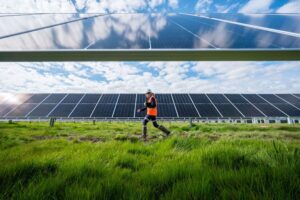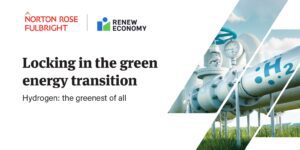US President Joe Biden has just announced massive increases in tariffs on Chinese steel and aluminium – as part of his push for decarbonising the US industry.
It’s the latest example of how global markets are now wanting green iron, and provides a big opportunity for Australian mining and manufacturing companies, where we are already the global iron ore powerhouse.
Australia can become the global green iron exporting superpower in this new zero-carbon economy.
A future made in Australia is where iron and other metal production is powered by Australian sun and wind and our zero-emissions metals are embedded in products right around the world.
By creating green iron, Australia can help reduce global emissions by up to 7 per cent, literally changing the world.
The world is undergoing the biggest economic transformation since the Industrial Revolution. A massive global wealth transfer is underway, from fossil fuel-based economies like ours, to zero carbon-leading nations.
Australia is at a fork in the road. Do we want to be a ‘dig and ship’ economy of the last century, or do we want to add value to our resources including iron ore and make green iron here in Australia?
Australia is the world’s largest iron ore exporter – worth $A133 billion in 2021-22. The Australian steel industry currently generates AU$29 billion in annual revenue and employs almost 140,000 people across the country.
About 90 per cent of the iron ore resources are in the Pilbara, in north-west WA although South Australia, Tasmania and other parts of WA also have important reserves of magnetite, which is ideal for making green steel.
Australia’s economic future and these high-paying jobs depend on our ability to add value to its critical and strategic minerals – and to make products for the future, including green iron. Australia’s reliance on iron ore and fossil fuel exports will put our entire economy and quality of life at risk.
These fossil fuel products are not what global markets will increasingly demand. China, the largest consumer of Australian iron ore, seeks to reduce its carbon footprint, posing imminent risks to Australia’s current export mix.
Some Australian companies see themselves as ‘fast followers’ when it comes to making green iron or green steel in Australia. Some even claim ‘green steel is not real’. Both these assertions are foolish.
The reality is that companies in Australia are already stepping up to the challenge. Real green steel prospects for Australia include Green Steel WA; Onesteel – Smart@UNSW; Fortescue; POSCO; CWP Global and CQ-H2 – Central Queensland Hydrogen Hub.
The Nordic countries are leading the way in producing green steel. The HYBRIT (Hydrogen Breakthrough Ironmaking Technology) in Sweden produced a delivery of green steel for Volvo in 2021 and aims to be commercial by 2026.
H2 Green Steel is building a green steel plant in northern Sweden and plans to commence commercial production in 2025. H2 Green Steel plans to produce 5 million tonnes of green steel from at least 1 gigawatt of electrolysers by 2030.
Luckily not all Australian companies have been continuing to invest in old fossil fuel based steel making technology and are getting ready to thrive in a net-zero carbon economy.
The South Australian government has committed AU$593 million to building a world leading green hydrogen power station, electrolyser, and storage facility near Whyalla.
The project will catalyse other green hydrogen projects in development, including potential use as a reductant in chemical processes such as the manufacture of green iron and green steel.
GFG Liberty Steel Australia’s Whyalla steel plant plans to produce 1.8 million tonnes of green iron which will supply Liberty’s network of electric arc furnaces across Australia, Asia, Europe and the UK.
“A place like Whyalla, for example, green steel is its future,” said Prime Minister Anthony Albanese on a trip to the region in September 2023.
Australia has all the ingredients to become a green iron exporting superpower, and use only green steel domestically, as a critical step to net zero. We are making good progress in places such as the Eyre Peninsula in South Australia and the Pilbara in WA.
However, Brazil, the Middle East and Africa are also in prominent positions to win the green iron race. Europe is already ahead in building the world’s first green steel plants.
The recent light on the hill speech by Prime Minister Anthony Albanese titled ‘A Future Made In Australia’ is the beacon our smart metals businesses have been waiting for.
The opportunity is real, and we must be bold, or we will miss the progressive opportunity of going from a fossil fuel export economy to a green metal export economy.
Now let’s get this done.
Scott Hamilton is a senior advisor for Smart Energy Council and an adjunct associate professor at Monash University. Joanna Kay is general manager of Zero Carbon Hydrogen Australia (a division of the Smart Energy Council).








